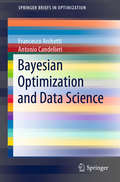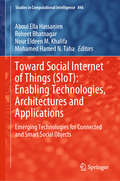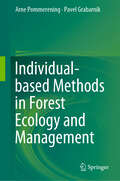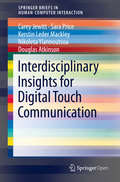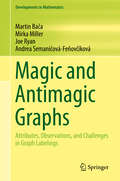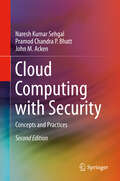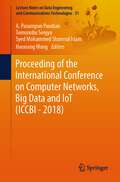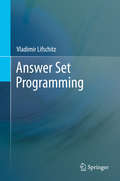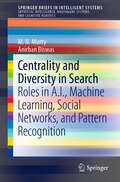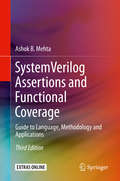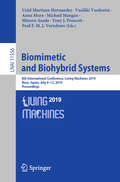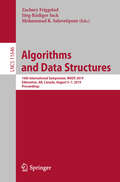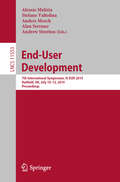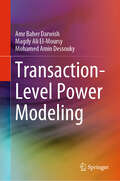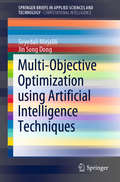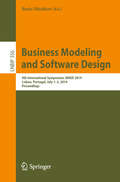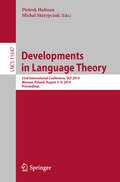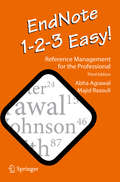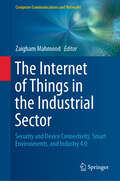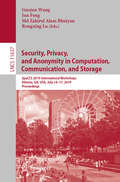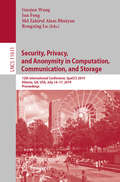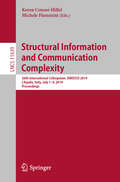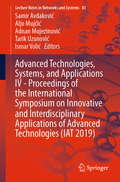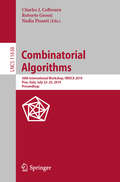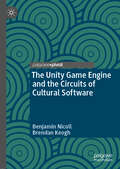- Table View
- List View
Bayesian Optimization and Data Science (SpringerBriefs in Optimization)
by Francesco Archetti Antonio CandelieriThis volume brings together the main results in the field of Bayesian Optimization (BO), focusing on the last ten years and showing how, on the basic framework, new methods have been specialized to solve emerging problems from machine learning, artificial intelligence, and system optimization. It also analyzes the software resources available for BO and a few selected application areas. Some areas for which new results are shown include constrained optimization, safe optimization, and applied mathematics, specifically BO's use in solving difficult nonlinear mixed integer problems. The book will help bring readers to a full understanding of the basic Bayesian Optimization framework and gain an appreciation of its potential for emerging application areas. It will be of particular interest to the data science, computer science, optimization, and engineering communities.
Toward Social Internet of Things: Emerging Technologies for Connected and Smart Social Objects (Studies in Computational Intelligence #846)
by Aboul Ella Hassanien Roheet Bhatnagar Nour Eldeen M. Khalifa Mohamed Hamed N. TahaThis unique book discusses a selection of highly relevant topics in the Social Internet of Things (SIoT), including blockchain, fog computing and data fusion. It also presents numerous SIoT-related applications in fields such as agriculture, health care, education and security, allowing researchers and industry practitioners to gain a better understanding of the Social Internet of Things
Individual-based Methods in Forest Ecology and Management
by Arne Pommerening Pavel GrabarnikModel-driven individual-based forest ecology and individual-based methods in forest management are of increasing importance in many parts of the world. For the first time this book integrates three main fields of forest ecology and management, i.e. tree/plant interactions, biometry of plant growth and human behaviour in forests. Individual-based forest ecology and management is an interdisciplinary research field with a focus on how the individual behaviour of plants contributes to the formation of spatial patterns that evolve through time. Key to this research is a strict bottom-up approach where the shaping and characteristics of plant communities are mostly the result of interactions between plants and between plants and humans. This book unites important methods of individual-based forest ecology and management from point process statistics, individual-based modelling, plant growth science and behavioural statistics. For ease of access, better understanding and transparency the methods are accompanied by R code and worked examples.
Interdisciplinary Insights for Digital Touch Communication (Human–Computer Interaction Series)
by Kerstin Leder Mackley Carey Jewitt Sara Price Nikoleta Yiannoutsou Douglas AtkinsonCommunication is increasingly moving beyond ‘ways of seeing’ to ‘ways of feeling’. This Open Access book provides social design insights and implications for HCI research and design exploring digitally mediated touch communication. It offers a socially orientated map to help navigate the complex social landscape of digitally mediated touch for communication: from everyday touch-screens, tangibles, wearables, haptics for virtual reality, to the tactile internet of skin. Drawing on literature reviews, new case-study vignettes, and exemplars of digital touch, the book examines the major social debates provoked by digital touch, and investigates social themes central to the communicative potential and societal consequences of digital touch: · Communication environments, capacities and practices · Norms associations and expectations · Presence, absence and connection · Social imaginaries of digital touch · Digital touch ethics and values The book concludes with a discussion of the significance of social understanding and methods in the context of Interdisciplinary collaborations to explore touch, towards the design of digital touch communication, ‘ways of feeling’, that are useable, appropriate, ethical and socially aware.
Magic and Antimagic Graphs: Attributes, Observations and Challenges in Graph Labelings (Developments in Mathematics #60)
by Martin Bača Mirka Miller Joe Ryan Andrea Semaničová-FeňovčíkováMagic and antimagic labelings are among the oldest labeling schemes in graph theory. This book takes readers on a journey through these labelings, from early beginnings with magic squares up to the latest results and beyond.Starting from the very basics, the book offers a detailed account of all magic and antimagic type labelings of undirected graphs. Long-standing problems are surveyed and presented along with recent results in classical labelings. In addition, the book covers an assortment of variations on the labeling theme, all in one self-contained monograph.Assuming only basic familiarity with graphs, this book, complete with carefully written proofs of most results, is an ideal introduction to graph labeling for students learning the subject. More than 150 open problems and conjectures make it an invaluable guide for postgraduate and early career researchers, as well as an excellent reference for established graph theorists.
Cloud Computing with Security: Concepts and Practices
by Naresh Kumar Sehgal John M. Acken Pramod Chandra BhattThis book provides readers with an overview of Cloud Computing, starting with historical background on mainframe computers and early networking protocols, leading to current concerns such as hardware and systems security, performance, emerging areas of IoT, Edge Computing etc. Readers will benefit from the in-depth discussion of cloud computing usage and the underlying architectures. The authors explain carefully the “why’s and how’s” of Cloud Computing, so engineers will find this book an invaluable source of information to the topic. This second edition includes new material on Cloud Computing Security, Threat Vectors and Trust Models, as well as best practices for a using dynamic cloud infrastructure, and cloud operations management. Several new examples and analysis of cloud security have been added, including edge computing with IoT devices.
Proceeding of the International Conference on Computer Networks, Big Data and IoT (Lecture Notes on Data Engineering and Communications Technologies #31)
by A. Pasumpon Pandian Tomonobu Senjyu Syed Mohammed Shamsul Islam Haoxiang WangThis book presents the proceedings of the International Conference on Computer Networks, Big Data and IoT (ICCBI-2018), held on December 19–20, 2018 in Madurai, India.In recent years, advances in information and communication technologies [ICT] have collectively aimed to streamline the evolution of internet applications. In this context, increasing the ubiquity of emerging internet applications with an enhanced capability to communicate in a distributed environment has become a major need for existing networking models and applications. To achieve this, Internet of Things [IoT] models have been developed to facilitate a smart interconnection and information exchange among modern objects – which plays an essential role in every aspect of our lives. Due to their pervasive nature, computer networks and IoT can easily connect and engage effectively with their network users. This vast network continuously generates data from heterogeneous devices, creating a need to utilize big data, which provides new and unprecedented opportunities to process these huge volumes of data. This International Conference on Computer Networks, Big Data, and Internet of Things [ICCBI] brings together state-of-the-art research work, which briefly describes advanced IoT applications in the era of big data. As such, it offers valuable insights for researchers and scientists involved in developing next-generation, big-data-driven IoT applications to address the real-world challenges in building a smartly connected environment.
Answer Set Programming
by Vladimir LifschitzAnswer set programming (ASP) is a programming methodology oriented towards combinatorial search problems. In such a problem, the goal is to find a solution among a large but finite number of possibilities. The idea of ASP came from research on artificial intelligence and computational logic. ASP is a form of declarative programming: an ASP program describes what is counted as a solution to the problem, but does not specify an algorithm for solving it. Search is performed by sophisticated software systems called answer set solvers.Combinatorial search problems often arise in science and technology, and ASP has found applications in diverse areas—in historical linguistic, in bioinformatics, in robotics, in space exploration, in oil and gas industry, and many others. The importance of this programming method was recognized by the Association for the Advancement of Artificial Intelligence in 2016, when AI Magazine published a special issue on answer set programming. The book will introduce the reader to the theory and practice of ASP. It will describe the input language of the answer set solver CLINGO, which was designed at the University of Potsdam in Germany and is used today by ASP programmers in many countries. It will include numerous examples of ASP programs and present the mathematical theory that ASP is based on. There will be many exercises with complete solutions.
Centrality and Diversity in Search: Roles in A.I., Machine Learning, Social Networks, and Pattern Recognition (SpringerBriefs in Intelligent Systems)
by M.N. Murty Anirban BiswasThe concepts of centrality and diversity are highly important in search algorithms, and play central roles in applications of artificial intelligence (AI), machine learning (ML), social networks, and pattern recognition. This work examines the significance of centrality and diversity in representation, regression, ranking, clustering, optimization, and classification. The text is designed to be accessible to a broad readership. Requiring only a basic background in undergraduate-level mathematics, the work is suitable for senior undergraduate and graduate students, as well as researchers working in machine learning, data mining, social networks, and pattern recognition.
System Verilog Assertions and Functional Coverage: Guide to Language, Methodology and Applications
by Ashok B. MehtaThis book provides a hands-on, application-oriented guide to the language and methodology of both SystemVerilog Assertions and Functional Coverage. Readers will benefit from the step-by-step approach to learning language and methodology nuances of both SystemVerilog Assertions and Functional Coverage, which will enable them to uncover hidden and hard to find bugs, point directly to the source of the bug, provide for a clean and easy way to model complex timing checks and objectively answer the question ‘have we functionally verified everything’. Written by a professional end-user of ASIC/SoC/CPU and FPGA design and Verification, this book explains each concept with easy to understand examples, simulation logs and applications derived from real projects. Readers will be empowered to tackle the modeling of complex checkers for functional verification and exhaustive coverage models for functional coverage, thereby drastically reducing their time to design, debug and cover. This updated third edition addresses the latest functional set released in IEEE-1800 (2012) LRM, including numerous additional operators and features. Additionally, many of the Concurrent Assertions/Operators explanations are enhanced, with the addition of more examples and figures. · Covers in its entirety the latest IEEE-1800 2012 LRM syntax and semantics; · Covers both SystemVerilog Assertions and SystemVerilog Functional Coverage languages and methodologies; · Provides practical applications of the what, how and why of Assertion Based Verification and Functional Coverage methodologies; · Explains each concept in a step-by-step fashion and applies it to a practical real life example; · Includes 6 practical LABs that enable readers to put in practice the concepts explained in the book.
Biomimetic and Biohybrid Systems: 8th International Conference, Living Machines 2019, Nara, Japan, July 9–12, 2019, Proceedings (Lecture Notes in Computer Science #11556)
by Uriel Martinez-Hernandez Vasiliki Vouloutsi Anna Mura Michael Mangan Minoru Asada Tony J. Prescott Paul F. M. J. VerschureThis book constitutes the proceedings of the 8th International Conference on Biomimetic and Biohybrid Systems, Living Machines 2019, held in Nara, Japan, in July 2019. The 26 full and 16 short papers presented in this volume were carefully reviewed and selected from 45 submissions. They deal with research on novel life-like technologies inspired by the scientific investigation of biological systems, biomimetics, and research that seeks to interface biological and artificial systems to create biohybrid systems.
Algorithms and Data Structures: 16th International Symposium, WADS 2019, Edmonton, AB, Canada, August 5–7, 2019, Proceedings (Lecture Notes in Computer Science #11646)
by Zachary Friggstad Jörg-Rüdiger Sack Mohammad R. SalavatipourThis book constitutes the refereed proceedings of the 16th International Symposium on Algorithms and Data Structures, WADS, 2019, held in Edmonton, AB, Canada, in August 2019. The 42 full papers presented together with 3 invited lectures, we carefully reviewed and selected from a total of 88 submissions. They present original research on the theory and application of algorithms and data structures in many areas, including combinatorics, computational geometry, databases, graphics, and parallel and distributed computing.
End-User Development: 7th International Symposium, IS-EUD 2019, Hatfield, UK, July 10–12, 2019, Proceedings (Lecture Notes in Computer Science #11553)
by Alessio Malizia Stefano Valtolina Anders Morch Alan Serrano Andrew StrattonThis book constitutes the refereed proceedings of the 7th International Symposium on End-User Development, IS-EUD 2017, held in Hatfield, UK, in July 2019. The 9 full papers and 8 short papers presented were carefully reviewed and selected from 35 submissions. The papers discuss progress in research around end-user development through, or towards, methods, socio-technical environments, intelligent agents, as well as the most effective end-user programming paradigms for smart environments. Papers and submissions in all categories addressed this specific theme together with topics that have been traditionally covered by the broader themes of end-user development, such as domain specific tools, spreadsheets, educational applications, and end user aspects.
Transaction-Level Power Modeling
by Amr Baher Darwish Magdy Ali El-Moursy Mohamed Amin DessoukyThis book describes for readers a methodology for dynamic power estimation, using Transaction Level Modeling (TLM). The methodology exploits the existing tools for RTL simulation, design synthesis and SystemC prototyping to provide fast and accurate power estimation using Transaction Level Power Modeling (TLPM). Readers will benefit from this innovative way of evaluating power on a high level of abstraction, at an early stage of the product life cycle, decreasing the number of the expensive design iterations.
Multi-Objective Optimization using Artificial Intelligence Techniques (SpringerBriefs in Applied Sciences and Technology)
by Seyedali Mirjalili Jin Song DongThis book focuses on the most well-regarded and recent nature-inspired algorithms capable of solving optimization problems with multiple objectives. Firstly, it provides preliminaries and essential definitions in multi-objective problems and different paradigms to solve them. It then presents an in-depth explanations of the theory, literature review, and applications of several widely-used algorithms, such as Multi-objective Particle Swarm Optimizer, Multi-Objective Genetic Algorithm and Multi-objective GreyWolf Optimizer Due to the simplicity of the techniques and flexibility, readers from any field of study can employ them for solving multi-objective optimization problem. The book provides the source codes for all the proposed algorithms on a dedicated webpage.
Business Modeling and Software Design: 9th International Symposium, BMSD 2019, Lisbon, Portugal, July 1–3, 2019, Proceedings (Lecture Notes in Business Information Processing #356)
by Boris ShishkovThis book constitutes the refereed proceedings of the 9th International Symposium on Business Modeling and Software Design, BMSD 2019, held in Lisbon, Portugal, in July 2019. It contains 12 full and 11 short papers. BMSD is a leading international forum that brings together researchers and practitioners interested in business modeling and its relation to software design. Particular areas of interest are: Business Processes and Enterprise Engineering; Business Models and Requirements; Business Models and Services; Business Models and Software; Information Systems Architectures and Paradigms; Data Aspects in Business Modeling and Software Development; Blockchain-Based Business Models and Information Systems; IoT and Implications for Enterprise Information Systems. The theme of BMSD 2019 was: REFLECTING HUMAN AUTHORITY AND RESPONSIBILITY IN ENTERPRISE MODELS AND SOFTWARE SPECIFICATIONS.
Developments in Language Theory: 23rd International Conference, DLT 2019, Warsaw, Poland, August 5–9, 2019, Proceedings (Lecture Notes in Computer Science #11647)
by Piotrek Hofman Michał SkrzypczakThis book constitutes the proceedings of the 23rd International Conference on Developments in Language Theory, DLT 2019, held in Warsaw, Poland, in August 2019. The 20 full papers presented together with three invited talks were carefully reviewed and selected from 30 submissions. The papers cover the following topics and areas: combinatorial and algebraic properties of words and languages; grammars, acceptors and transducers for strings, trees, graphics, arrays; algebraic theories for automata and languages; codes; efficient text algorithms; symbolic dynamics; decision problems; relationships to complexity theory and logic; picture description and analysis, polyominoes and bidimensional patterns; cryptography; concurrency; celluar automata; bio-inspired computing; quantum computing.
EndNote 1-2-3 Easy!: Reference Management for the Professional
by Abha Agrawal Majid RasouliThis book is intended for healthcare professionals, biomedical researchers, health policy experts, and graduate students who frequently write and publish scientific manuscripts in peer reviewed journals. This new edition updates earlier versions with an emphasis on the most currently available Clarivate Analytics software application EndNote X9, a widely used reference management software. For first-time users of EndNote X9, this book is a comprehensive and well-illustrated instruction manual for getting started, including detailed instructions on installation, creating reference libraries, and ultimately creating complete and accurate citation-based bibliographies necessary to achieve successful peer reviewed publications. There is also a full chapter devoted to careful guidance for the growing practice of citing references from online internet sources. For existing “power users” of current and earlier versions of EndNote, this book provides quick and easy access to a comprehensive compendium of nuanced and advanced features of this powerful software, with an emphasis on providing greater ease and control in coordinating and curating research materials and bibliographies with research collaborators and scientific writing teams. The authors have also added new, state-of-the-art “how-to” guidance on a variety of methods of using EndNote, including PubMed, Google Scholar, Web of Science, Scopus and others. Like many legacy software systems, Clarivate Analytics has also begun to offer an online “desktop” version of EndNote, a topic which is now also covered in Chapter 10 (EndNote Online) of this new edition.
The Internet of Things in the Industrial Sector: Security and Device Connectivity, Smart Environments, and Industry 4.0 (Computer Communications and Networks)
by Zaigham MahmoodThis book has a focus on the development and deployment of the Industrial Internet of Things (IIoT) paradigm, discussing frameworks, methodologies, benefits and limitations, as well as providing case studies of employing the IoT vision in the industrial domain. IIoT is becoming an attractive business reality for many organisations such as manufacturing, logistics, oil and gas, energy and other utilities, mining, aviation, and many more. The opportunities for this paradigm are huge, and according to one report, the IIoT market is predicted to reach $125 billion by 2021. The driving philosophy behind the IIoT is that smart machines are better than humans at accurately capturing, analysing and communicating real-time data. The underlying technologies include distributed computing, machine learning, artificial intelligence, and machine-to-machine communication, with a typical IIoT system consisting of intelligent systems (applications, controllers, sensors, and security mechanisms), data communication infrastructure (cloud computing, edge computing, etc.), data analytics (to support business intelligence and corporate decision making), and most importantly the human element. The promised benefits of the IIoT include enhanced safety, better reliability, smart metering, inventory management, equipment tracking, and facilities management. There are, however, numerous issues that are also becoming the focus of active research, such as concerns regarding service availability, data security, and device communication. Lack of ubiquitous interoperability between heterogeneous devices is also a major concern. This book intends to fill a gap in the IIoT literature by providing the scientific contributions and latest developments from researchers and practitioners of international repute, focusing on frameworks, methodologies, benefits, and inherent issues/barriers to connected environments, especially in industrial settings.The intended audience includes network specialists, hardware engineers, and security experts who wish to adopt newer approaches for device connectivity, IoT security, and sensor-based devices design. University level students, researchers and practitioners will also find the latest innovation in technology and newer approaches relevant to the IIoT from a distributed computing perspective.
Security, Privacy, and Anonymity in Computation, Communication, and Storage: SpaCCS 2019 International Workshops, Atlanta, GA, USA, July 14–17, 2019, Proceedings (Lecture Notes in Computer Science #11637)
by Guojun Wang Jun Feng Md Zakirul Alam Bhuiyan Rongxing LuThis book constitutes the refereed proceedings of six symposiums and two workshops co-located with SpaCCS 2019, the 12th International Conference on Security, Privacy, and Anonymity in Computation, Communication, and Storage. The 26 full papers were carefully reviewed and selected from 75 submissions. This year's symposiums and workshops are: SPIoT 2019 – Security and Privacy of Internet of Things; TSP 2019 – Trust, Security and Privacy for Emerging Applications; SCS 2019 – Sensor-Cloud Systems; UbiSafe 2019 – UbiSafe Computing; ISSR 2019 – Security in e-Science and e-Research; CMRM 2019 – Cybersecurity Metrics and Risk Modeling.
Security, Privacy, and Anonymity in Computation, Communication, and Storage: 12th International Conference, SpaCCS 2019, Atlanta, GA, USA, July 14–17, 2019, Proceedings (Lecture Notes in Computer Science #11611)
by Guojun Wang Jun Feng Md Zakirul Alam Bhuiyan Rongxing LuThis book constitutes the refereed proceedings of the 12th International Conference on Security, Privacy, and Anonymity in Computation, Communication, and Storage, SpaCCS 2019, held in Atlanta, GA, USA in July 2019. The 37 full papers were carefully reviewed and selected from 109 submissions.The papers cover many dimensions including security algorithms and architectures, privacy-aware policies, regulations and techniques, anonymous computation and communication, encompassing fundamental theoretical approaches, practical experimental projects, and commercial application systems for computation, communication and storage.
Structural Information and Communication Complexity: 26th International Colloquium, SIROCCO 2019, L'Aquila, Italy, July 1–4, 2019, Proceedings (Lecture Notes in Computer Science #11639)
by Keren Censor-Hillel Michele FlamminiThis book constitutes the refereed conference proceedings of the 26th International Colloquium on Structural Information and Communication Complexity, SIROCCO 2019, held in L’Aquila, Italy, in July 2019.The 19 full papers and 9 short papers presented in this book were carefully reviewed and selected from 39 submissions. They are devoted to the study of the interplay between structural knowledge, communication, and computing in decentralized systems of multiple communicating entities.
Advanced Technologies, Systems, and Applications IV -Proceedings of the International Symposium on Innovative and Interdisciplinary Applications of Advanced Technologies (Lecture Notes in Networks and Systems #83)
by Samir Avdaković Aljo Mujčić Adnan Mujezinović Tarik Uzunović Ismar VolićThis book presents the scientific outcomes of the conference 11th Days of Bosnian-Herzegovinian American Academy of Arts and Sciences, held in Sarajevo, Bosnia and Herzegovina, June 20–23, 2019. Including innovative applications of advanced technologies, it offers a uniquely comprehensive, multidisciplinary and interdisciplinary overview of the latest developments in a broad range of technologies and methodologies, viewed through the prism of computing, networking, information technology, robotics, complex systems, communications, energy, mechanical engineering, economics and medicine, among others.
Combinatorial Algorithms: 30th International Workshop, IWOCA 2019, Pisa, Italy, July 23–25, 2019, Proceedings (Lecture Notes in Computer Science #11638)
by Charles J. Colbourn Roberto Grossi Nadia PisantiThis book constitutes the refereed post-conference proceedings of the 30th International Workshop on Combinatorial Algorithms, IWOCA 2019, held in Pisa, Italy, in July 2019. The 36 regular papers presented in this volume were carefully reviewed and selected from 73 submissions. They cover diverse areas of combinatorical algorithms, complexity theory, graph theory and combinatorics, combinatorial optimization, cryptography and information security, algorithms on strings and graphs, graph drawing and labelling, computational algebra and geometry, computational biology, probabilistic and randomized algorithms, algorithms for big data analytics, and new paradigms of computation.
The Unity Game Engine and the Circuits of Cultural Software
by Benjamin Nicoll Brendan KeoghVideogames were once made with a vast range of tools and technologies, but in recent years a small number of commercially available 'game engines' have reached an unprecedented level of dominance in the global videogame industry. In particular, the Unity game engine has penetrated all scales of videogame development, from the large studio to the hobbyist bedroom, such that over half of all new videogames are reportedly being made with Unity. This book provides an urgently needed critical analysis of Unity as ‘cultural software’ that facilitates particular production workflows, design methodologies, and software literacies. Building on long-standing methods in media and cultural studies, and drawing on interviews with a range of videogame developers, Benjamin Nicoll and Brendan Keogh argue that Unity deploys a discourse of democratization to draw users into its ‘circuits of cultural software’. For scholars of media production, software culture, and platform studies, this book provides a framework and language to better articulate the increasingly dominant role of software tools in cultural production. For videogame developers, educators, and students, it provides critical and historical grounding for a tool that is widely used yet rarely analysed from a cultural angle.
